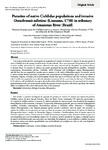Por favor, use este identificador para citar o enlazar este ítem:
http://www.alice.cnptia.embrapa.br/alice/handle/doc/990082Registro completo de metadatos
| Campo DC | Valor | Lengua/Idioma |
|---|---|---|
| dc.contributor.author | BITTENCOURT, L. S. | pt_BR |
| dc.contributor.author | PINHEIRO, D. A. | pt_BR |
| dc.contributor.author | CARDENAS, M. Q. | pt_BR |
| dc.contributor.author | FERNANDES, B. M. | pt_BR |
| dc.contributor.author | DIAS-TAVARES, M. | pt_BR |
| dc.date.accessioned | 2014-07-22T06:01:22Z | - |
| dc.date.available | 2014-07-22T06:01:22Z | - |
| dc.date.created | 2014-07-09 | pt_BR |
| dc.date.issued | 2014 | pt_BR |
| dc.identifier.citation | Brazilian Journal of Veterinary Parasitology, Jaboticabal, v. 23, n. 1, p. 44-54, 2014. | pt_BR |
| dc.identifier.uri | http://www.alice.cnptia.embrapa.br/alice/handle/doc/990082 | pt_BR |
| dc.description | This study provides the first investigation on acquisition of parasites in invasive O. niloticus by parasite species of native Cichlidae from the Igarapé Fortaleza basin, Northern Brazil. There were examined 576 specimens of 16 species of native cichlids and invasive O. niloticus collected in the main channel and the floodplain area of this tributary of Amazon River. The invasive O. niloticus was poorly parasitized having only Ichthyophthirius multifiliis, Trichodina centrostrigeata, Paratrichodina africana, Trichodina nobilis (Protozoa) and Cichlidogyrus tilapiae (Monogenoidea), and this host has not acquired any parasite species common to the native ichthyofauna region. In contrast, species of native cichlids showed rich fauna of parasites with predominance of Monogenoidea species, larvae and adults of Nematoda, Digenea, Cestoidea and Acanthocephala, besides four species of Protozoa and four Crustacea. However, only T. nobilis was acquired by native fish, the Aequidens tetramerus, which is a new host for this exotic Trichodinidae. In O. niloticus, well established in the region, the small number of helminth species may be associated with its rusticity, good adaptation in the new environment and also the presence of native parasites with relative specificity, but without ability to complete its life cycle in this invasive host of this ecosystem. | pt_BR |
| dc.language.iso | eng | eng |
| dc.rights | openAccess | eng |
| dc.subject | Animal parasite | pt_BR |
| dc.subject | Invasão biológica | pt_BR |
| dc.subject | Biological invasion | pt_BR |
| dc.subject | Parasito de peixe | pt_BR |
| dc.subject | Fish parasite | pt_BR |
| dc.subject | Colonization | pt_BR |
| dc.subject | Parasito animal | pt_BR |
| dc.title | Parasites of native Cichlidae populations and invasive Oreochromis niloticus (Linnaeus, 1758) in tributary of Amazonas River (Brazil). | pt_BR |
| dc.type | Artigo de periódico | pt_BR |
| dc.date.updated | 2019-05-29T11:11:11Z | pt_BR |
| dc.subject.thesagro | Colonização | pt_BR |
| riaa.ainfo.id | 990082 | pt_BR |
| riaa.ainfo.lastupdate | 2019-05-29 -03:00:00 | pt_BR |
| dc.contributor.institution | LUANA SILVA BITTENCOURT, Programa de Pós-graduação em Biodiversidade Tropical – PPGBio, Universidade Federal do Amapá – UNIFAP, Macapá, AP Brazil; MARCOS TAVARES DIAS, CPAF-AP. | pt_BR |
| Aparece en las colecciones: | Artigo em periódico indexado (CPAF-AP)  | |
Ficheros en este ítem:
| Fichero | Descripción | Tamaño | Formato | |
|---|---|---|---|---|
| CPAFAP2014Parasitesofnative.pdf | 1,04 MB | Adobe PDF |  Visualizar/Abrir |









